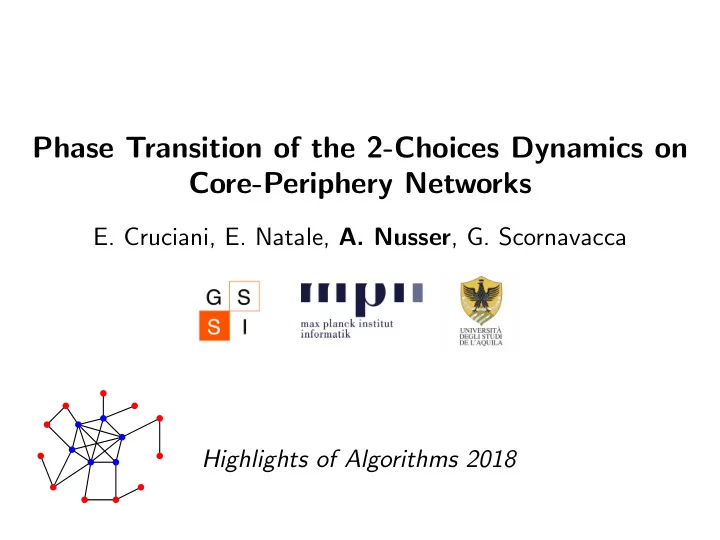

Phase Transition of the 2-Choices Dynamics on Core-Periphery Networks E. Cruciani, E. Natale, A. Nusser , G. Scornavacca Highlights of Algorithms 2018
Opinion Dynamics Given: • graph • node coloring Dynamics: • Simple update rule of a node’s color... • ...depending on its neighbors’ colors. → Updates happen in synchronous rounds .
Opinion Dynamics Given: • graph • node coloring Dynamics: • Simple update rule of a node’s color... • ...depending on its neighbors’ colors. → Updates happen in synchronous rounds .
Opinion Dynamics Given: • graph • node coloring Dynamics: • Simple update rule of a node’s color... • ...depending on its neighbors’ colors. → Updates happen in synchronous rounds . . . .
2-Choices Dynamics picks two random neighbors
2-Choices Dynamics change if same color picks two random neighbors
2-Choices Dynamics change if same color picks two random neighbors if different color keep
Core-Periphery Networks Core: Set of densely connected nodes. Periphery: Remaining nodes, loosely connected and dominated by core. | c ( C , P ) | dominance: | c ( P , P ) |
Main Result When running the 2-Choices dynamics on core-periphery networks with • core initially blue • periphery initially red
Main Result When running the 2-Choices dynamics on core-periphery networks with • core initially blue • periphery initially red then • if dominance is above a universal threshold: → consensus on blue color in O (log n ) rounds w.h.p. • otherwise: → metastable phase for n ω (1) rounds w.h.p.
Experiments Tests conducted on 70 real-world networks (SNAP, KONECT).
See you at the poster session! :)
19th Max Planck Advanced Course on the Foundations of Computer Science 13 - 17 August 2018, Saarbrücken, Germany Fine-Grained Complexity and Algorithms Ramamohan Paturi Amir Abboud Danupon Nanongkai UC San Diego IBM Almaden KTH Foundations of Fine- Hardness in P Dynamic graphs: algorithms, grained Complexity conditional lower bounds, and complexity classes google „ADFOCS“
Recommend
More recommend